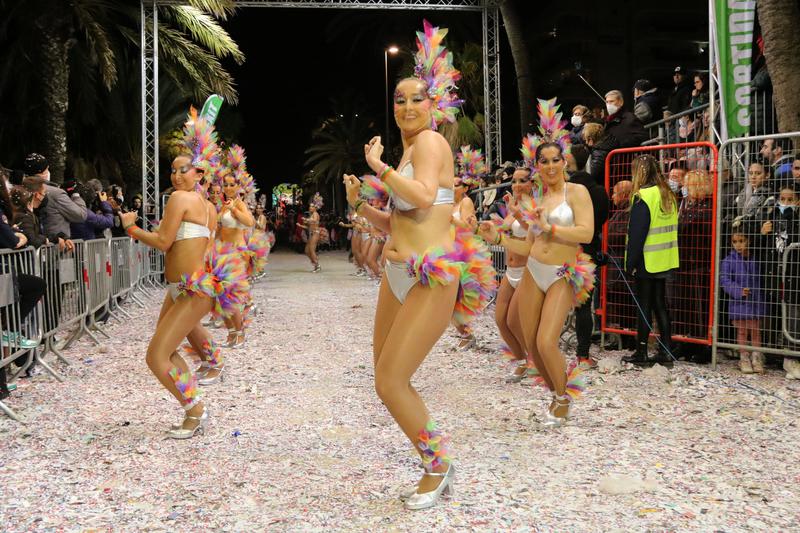2023 guide to Carnival in Catalonia: parades, meringue fights, sardine burials and more
Candy, costumes, and indulgent foods from (at least!) February 16 to 22

It's Carnival again, a period of fierce merriment and joy here in Catalonia. This year 'Carnaval' or 'Carnestoltes' celebrations will take place from February 16 to 22, beginning even earlier in a handful of cities and towns.
Check out the Catalan News guide below to make the most of these exhilarating festivities:
Thursday, February 16
Move over Mardi Gras, here we celebrate 'Dijous Gras'! 'Dijous Gras', or Fat Thursday, marks the beginning of Carnival and people are actively encouraged to indulge in fatty foods such as botifarra d'ou (egg sausage) and truita (omelette) or coca de llardons (pork crackling cake).
As far as festivities are concerned, Thursday is a good day to get your Carnival groove on. In Vilanova i la Geltrú, a coastal town south of Barcelona, there will be what locals call 'La Merengada' - that is to say, a massive meringue food war. Children (and more than a few adults) will gather at 5:30 pm in front of Blanch bakery on Avda. Francesc Macià, 43 to partake in the annual sticky dessert hurling ritual.
Later on in the evening there will be 'Arribo' parades all over Catalonia as the king or queen of Carnestoltes "arrives" to take part in the fun. Sitges, directly north of Vilanova i la Geltrú on the Garraf coast, is famous for these debaucherous pageants, but Barcelona and other towns' aren't too shabby either. Sitges' show starts at 7 pm below the steps to the seaside church, while the Catalan capital's kicks off at 6:30 pm on La Rambla boulevard.
Friday, February 17
Towns like Vilanova i la Geltrú celebrate the 'Arribo' on Friday, not Thursday, as do a number of Barcelona's districts, some of which will have their own smaller parades. Les Corts's festivities will start at 4:30 pm at Plaça de Comas, while Sarrià - Sant Gervasi's will begin at 6:30 pm at plaça de Pere Figuera i Serra, 1.
Friday in particular is a big deal for schoolchildren in Catalonia as it is a day they'll be sure to dress up for parades in their hometowns. This comes, of course, after a week of very specific attire at school: pajama day, mismatched socks day… you get the picture. It's also one of the nights you're most likely to see adults out in costume at a club or bar.
Saturday, February 18
Carnival in the northern town of Solsona is done differently. Not only does it begin Friday and not Thursday, but it's known for its 'mata-ruc' donkey-killing ceremony. This, thankfully, is not as appalling as it sounds: it's only a fake donkey that's hung from the church bell tower. Head to the very aptly named Plaça del ruc square at 7:30 pm to witness this bizarre sight.
Sunday, February 19
Sunday is a big day for parades plural as there is more often than not more than one in the same city or town on this day. In towns like Sitges or Sabadell, the children's parade will begin around midday, with a racier one for adults in the evening.
For those who didn't have enough with 'la merengada', there will also be a candy-throwing war known as 'la Comparsa' on Sunday in Vilanova i la Geltrú.
Monday, February 20
Monday is usually the day of rest after a weekend of Carnival madness, but this is not always the case! In Roses, a town on the Costa Brava, it's actually the last day of Carnival. Unlike the rest of Catalonia's sardine burials, Roses is on Monday. The town will also be hosting an 'arrossada popular' rice meal for the community.
Tuesday, February 21
In some places, such as Vidreres near Girona and Ponts near Lleida, Tuesday (Mardi Gras much of the Carnival-celebrating world but Carnival Tuesday or 'Dimarts de Carnaval' here) is the day locals eat 'ranxo' soup, a special meat and vegetable stew made from the ingredients residents bring to the town square.
Don't miss Sitges' Extermination parade on Tuesday night, one of Catalonia's most popular Carnival processions. Beginning at 11 pm, the afterparty at Teatre Prado will be sure to go on until the wee hours of the morning.
Wednesday, February 22
Carnival comes to a close with the symbolic burial of the sardine ('enterrament de la sardina') on Ash Wednesday, or 'Dimecres de Cendra', as revelers put an end to the period of excess before Lent.
In the Catalan capital alone, Ciutat Vella, Sants-Montjuïc, Les Corts, Horta-Guinardó, Nou Barris, Sant Andreu, and Sant Martí will all be burying sardines - more than enough fish funerals for Barcelona residents and visitors to pick from!